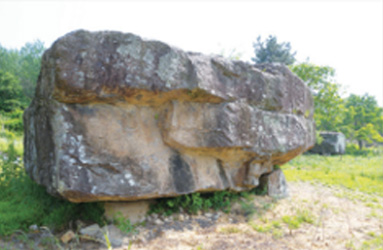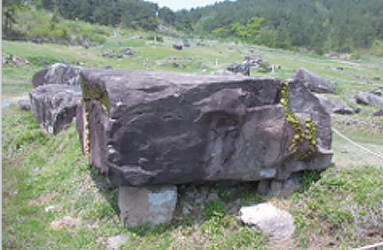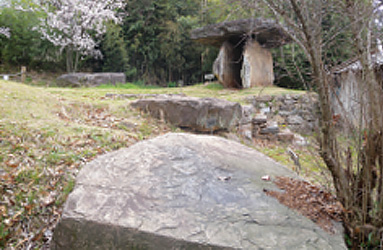
Dolmen ruins
and is located around Jukrim-ri, Gochang-eup, Sanggap-ri and Bongdeok-ri, Asan-myeon,
and Dosan-ri, Gochang-eup, which can be said to be the world's largest group of Dolmens.
Distribution
This area was designated as Historic Site No. 391 in December 1994, and the protected area, together with the nearby Dosanri Dolmen, reaches 105.14h. Most of the Dolmens form a group in the range of 20 to 67m above sea level along the southern foot of the mountain range, centering on the valley field, and are distributed along the Gochangcheon Stream and the contour line. There is farmland consisting of rice fields to the south, and forests are formed along the slopes to the north, and settlements and fields are distributed along the gentle slope from east to west along the boundary between rice fields and forests. Dolmen are mainly distributed on the boundary between forests and farmlands.
From the Gochang Dolmen Museum side, you can see the entire Dolmen group in Juknim-ri, Sanggap-ri and Bongdeok-ri, and you can also see the Dosan-ri Dolmen group from the Juknim-ri side. The Dolmens are classified into three districts: District 1, District 2, and Dosan District. Total 447 Dolmens are distributed, and various types of Dolmens such as table type, checkerboard type, and open stone type Dolmens are mixed, providing important data on the occurrence, development and character of Dolmens.
The number of Gochang Dolmens was 442 (excluding Dosan Dolmens) based on a report by the Honam Cultural Heritage Research Institute in 2001. 2 were added to Group 1 of District 2, but 2 of Group 6 of District 2 were damaged, resulting in total 447 Dolmens including 5 Dosan-ri Dolmens. On the other hand, Gochang-gun operates Dolmens by 6 courses, courses 1~3 of Jukrim-ri Dolmens, course 4 of quarry, course 5 of Sanggap-ri and Bongdeok-ri Dolmen, and course 6 of Dosan-ri Dolmen respectively focusing on the characteristics of the Dolmens built in rows below the ridge.
-
 Gochang Dolmen Ruins (Course 2)
Gochang Dolmen Ruins (Course 2)
-
 Gochang Dolmen Ruins (Course 3)
Gochang Dolmen Ruins (Course 3)
-
 Gochang Dolmen Ruins (Course 6)
Gochang Dolmen Ruins (Course 6)
Distribution of Dolmens by tour course
| Classification | Course 1 | Course 2 | Course 3 | Course 4 | Course 5 | Course 6 |
|---|---|---|---|---|---|---|
| Number of Dolmens | 51units | 41units | 128units | 23 points of quarry | 222 units | 5 units |
| Classification by investigation area | Area 2 (Group 5, 6) | Area 2 (Group 4) | Area 2 (Group 2, 3) | Area 2 (Group 1) Area 1 (Group 1, 2, 3, 4) |
Area 2 (Group 5, 6) | |
| Administration area | Jukrim-ri Dolmen group(1) of Gochang-eup | Dolmen group(2) of Jukrim-ri, Gochang-eup. Dolmen group, Bongdeok-ri of Sanggap-ri |
||||
Characteristics of Gochang-gun Dolmen
First
Considering that about 440 Dolmens are concentrated in a narrow area of 1.8 km, this density shows the most dense distribution in the world.
Second
The fact that Dolmens of the table type, checkerboard type, open stone type, and the ground stone box type Dolmen which can be transformation from table type to checkerboard type, are distributed in this area.
The ground stone box is considered to be a modified form of the table type in which a stone wall structure is made on the ground by attaching a low flagstone or several flagstones to the lower part of the cover stone, and a supporting stone is erected at the height of the flagstone on the outer edge so that the tomb is located on the ground or in a semi-basement. (1992 Report: Total 45 DolmensThird
Magnificent and gigantic checkerboard-type Dolmens supporting the cover stones with pillar-shaped supporting stones are located here and there, showing dignity and scenery appropriate for a Dolmen kingdom.
Fourth
During the investigation in 2004, pieces of plain earthenware and red polished earthenware were found, and a piece of polished stone sword handle was found on the surface of a hill near Sanggap-ri Dolmen (Dolmen A, B, C) excavated and investigated in 1965. However, few artifacts have been found from Dolmens in this area.
Fifth
The Dolmen groups are distributed surrounding 15 points around Mt. Seongteulbong and 8 points around Mt, Jungbong and the quarry for Dolmen exists.
Sixth
There are many pillar-shaped supporting stones, which are difficult to see in other areas.